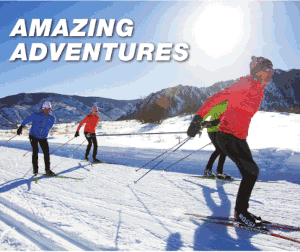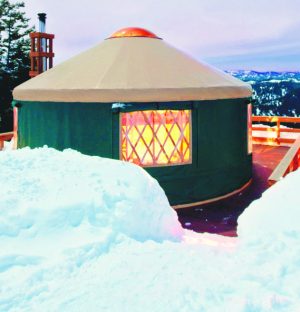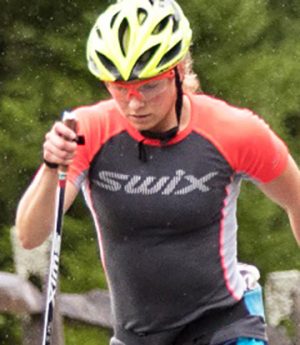January 27, 2016 (Canmore, AB) – Salomon recently hosted two product launch events in North America to officially announce their new, and much anticipated, Prolink binding system. On Jan. 6 the U.S. debut was held at Jeremy Ranch near Salt Lake City in conjunction with the Outdoor Retailer Winter show while the Canadian debut was held at the Canmore Nordic Centre on Jan. 11-12. SkiTrax was on hand for both events – read our U.S. coverage here.
In what may be one of the biggest Nordic equipment releases in decades, and certainly a surprise move that has rocked the world of cross-country skiing, Salomon has come out with a completely new (to Salomon) binding system for the first time since the SNS Profil was introduced to the market in the early 90s. Many readers will be familiar with the world of platform battles: 8-Track/Cassette, VHS/Betamax, Blu-ray/HD-DVD, Windows/Mac, etc. Generally this becomes a hassle for the consumer because often very similar products are being offered, each with their own strengths and weaknesses, and the consumer is forced to choose. This has certainly been the case with the SNS/NNN battle that has been waged for decades in the cross-country ski market.
Let’s stop right here and address the elephant in the room. What is Prolink? Why is it important? Many initial reports on the release of the Prolink system have tiptoed around the big question: Is this a true NNN-compatible system? The short answer is a solid YES, Salomon has released NNN-compatible boots and bindings – for both skate and classic – which will allow you to seamlessly use Prolink Salomon boots with Salomon’s new Prolink binding or any NNN binding you choose and vice-versa. There are some nuances to the compatibility which we’ll discuss in more detail later in this article but for those wanting a short concise answer, there you have it.
The Salomon product release events were a chance for sales reps and retailers to not only see the Prolink system in person for the first time but to actually take the new gear out for a test-ski! SkiTrax had exclusive access to these events and we’ve now taken the opportunity to test the new Prolink system quite extensively.
The most recent event was the Canadian release which took place in Canmore, AB at the world-class Canmore Nordic Centre on Jan. 11-12. Top retailers from across the country were invited to join Canadian Salomon sales and marketing reps to try out the new gear scheduled to hit stores in the fall of 2016. Nicolas Stamos, one of the head sales managers for Salomon international, was also on hand to field questions from retailers and present the many details on the new Prolink system.
Key Salomon Canadian retailers at the launch included – Radical Edge (Brian McKeown), La Cordee (Dominique Payette), Espresso Sport (Luc Baril), Boutique Courir (Gilles Labre), Wildrock Outfitters (Jamie Elcome), La Vie Sportive (Raymond Lavoie), Hardwood Hills (Bob Picken), Stride and Glide (Shayne Hoehn), Fresh Air Experience Kelowna (Jim Bates), Fast Trax (Jack Cook and Shauna), TrailSports (John Gallagher), Norseman Ski Shop (Dave Betch and Julie), Totem Outfitters (Perry and Kathryn), Campers Village (David Arsenault), Gerick Sports (Pat Fagan and Chris Bloch-Hensen), Eb’s Source for Adventure (Kevin Robinson), Fresh Air Experience Thunder Bay (Alan Cranston), Sports Experts Canmore (Craig Westlake).
![(l-r) Luc Baril (Espresso Sports), Gilles Lachance (Montreal rep), Raymond Lavoie, (La Vie Sportive) at the Salomon Prolink launch [P] Salomon Canada](http://skitrax.com/wp-content/uploads/2016/01/Nordic-launch2-copy.jpg)
One topic raised was about the patents on the NNN system. Salomon maintains they have not infringed on any intellectual property rights with the development of their Prolink system which they claim is based on publicly available technology, and the company is moving full steam ahead for a full release in the fall of 2016. This has not stopped rumours of lawsuits being filed against them and articles in the Norwegian press stating that Rottefella has sent letters to Amer Sports (Salomon’s parent company) claiming “violation of good business practices and counterfeiting” and will be taking action – a situation which we’ll continue to monitor. The Prolink system is the culmination of at least three years of development by Salomon, incredibly kept under complete wraps until the design was leaked just before Christmas by a Russian source.
Now that we have the history and legal bits out of the way, let’s get down to the actual testing! The day started with a quick info session from Salomon and then it was time to hit the perfectly groomed tracks up at the Nordic Centre on a gorgeous sunny day in Canmore! I immediately had a chance to jump on a pair of the new Salomon S-Lab Carbon skis, paired with the new Prolink Carbon bindings and Prolink S-Lab Skate Pro boots.Before I get into my review and first impressions, I feel that I should offer full disclosure on my background and any potential bias. I finished my race career as a Fischer/Rotefella/Alpina sponsored athlete and still ski these same brands three years post retirement. Like many skiers, I started my career as a Fischer/Salomon athlete and spent many years racing on the popular Fischer ski/Salomon boot setup. When Fischer and Salomon went their separate ways, I was forced to choose and ultimately ended up in the Fischer/NNN camp. Both were great combos, each with their own strengths.
From first stepping into the new Prolink bindings to taking my first few strides, the transition was seamless. The binding was super easy to step into and very easy to open/close, feeling solid and precise. The boot/binding/ski combo felt very connected, great stability, and great feel for the snow. It did take me a few kilometers to get used to the mounting point that Salomon uses which is slightly back of the balance point of the ski causing the tips to drag when you’re not used to it but Salomon says that utilizing this mount point helps accelerate the ski when weight is shifted onto it and I quickly got used to the slight difference in ski position.
As I expected, the complete Prolink system works great, this isn’t Salomon’s first rodeo after all, so it was time to really put things to the test with the Prolink boots and jump on a pair of Fischer Speedmax skis with NIS Xcelerator bindings. The Salomon Prolink boots engaged with the Xcelerator binding seamlessly and without hesitation. Good start. I took off for a ski and was immediately impressed with how connected to the ski the Salomon boots felt, it was somewhat nostalgic to be back cruising around on Fischer skis and Salomon boots, something I have not done in almost 10 years. The feeling was great. Not sure what I was expecting, maybe something more like a first awkward school dance, but the integration was seamless. From the first stride, everything felt comfortable and stable. I was also reminded of just how nice the Salomon skate boots were, and still are. A great example of Salomon doing what they have always done better than most, boots.
Next up, it was time to turn the tables and put my trusty Alpina skate boots on and take the Salomon skis with Prolink bindings out for a spin. Again, the Alpina boots engaged with the Prolink binding with ease and I headed out for another loop. After skiing for just a few strides, there was a hint of having met for the first time. Another nuance was that the Salomon skis somehow felt slower with this set up, and this was still the case when I put a Salomon Prolink boot on one foot and an Alpina boot on the other to compare.
Another tester on Rossignol boots had similar feelings. It may have been the specific flex of the skis and the pressures on it from the boot, along with the conditions that day – tough to say in our short window of test time. To be clear, these were subtleties that most skiers would likely not notice, or would simply get used to after some time.
One of the final tests for the new Prolink skate bindings was a comparison to the SNS Pilot skate bindings. Many diehard Salomon fans are adamant that the Pilot system offers more ski control for skating. I remember this being a concern of mine way back when I switched from Salomon to NNN however my concerns quickly faded after trying the latest offering from Alpina at the time in the ESK Elite Ti-Carbon Skate boot.
The Pilot bindings definitely had their benefits in the days of the older SNS Profil Skate boots which were incredibly soft and had a lot of torsional flex to them by today’s standards. The second anchor point of the Pilot binding seemed to help stabilize the boot and offer more control. Fast-forward to the current skate boots on the market and nearly every boot above a recreational model offers some combination of carbon cuff and/or sole, meaning modern Salomon SNS skate boots are much more stiff, especially torsionally, than the boots of the early 2000’s.
I have found that this is certainly the case with the Salomon S-LAB Skate Pro boots. I had the chance to ski on and directly compare one S-Lab boot with an SNS Pilot binding and one S-LAB boot with a Prolink binding. The results? I’m quite certain that if I were blindfolded and taken out for a ski, I would not be able to pick out the foot with the Pilot boot/binding. The only real giveaway is that the Pilot boot/binding sits higher off the ski than the Prolink combo, which for me is another benefit to the Prolink system. When you add in the weight savings, 260g for a pair of the top of the line Salomon Pilot Carbon RS bindings compared to just 215g for a pair of the Prolink Carbon Skate bindings (claimed by Salomon and include screws), I really can’t come up with a good reason to choose the Pilot boot/binding system over the Prolink system.
This raises another burning question, one that I heard asked repeatedly by retailers at the launch event: is this the beginning of the end for the SNS binding system?
Jack Cook of Fast Trax Run & Ski Shop in Edmonton, AB doesn’t necessarily think so. “If you were to ski on both systems the new Prolink seems to be the better system when it comes down to ski feel but when you factor in stability, the SNS system still seems to provide better support in terms of step turns, steeping in and out of the track and herring bone,” said Cook.
Salomon also maintains that they do not plan to discontinue the SNS system and that they will continue to produce SNS boots/bindings for the foreseeable future, however some seem to think the writing is on the wall and only time will tell.
After a quick break for lunch, it was time to hit the snow once again, this time to take the classic gear out for a burn. As with the Prolink skate boots/bindings, the Prolink Salomon classic boots and bindings worked flawlessly, no difficulties at all stepping into and closing the bindings. I took off for a quick ski and felt right at home on the Salomon Prolink setup. Once again, I was impressed with how connected the boot felt to the ski.
Compared to NNN, the feel of the classic Prolink was very similar, save for the more cushy, slightly softer feeling of the Salomon S-LAB classic boots which are great for comfort and fit. The racer in me prefers a stiffer feel and more direct feedback with the ski for a raw racing affect.
As with the skate testing, I tried the Salomon Prolink classic boots on a pair of Fischer Carbonlite Classic skis with NIS Xcelerator bindings. The integration was seamless and the Salomon boots felt right at home on the NNN/Fischer setup. Next up, I tried my Alpina classic boots on a pair of Salomon S-LAB Classic skis with Prolink bindings and as with the same skate combo, the boots engaged easily, functioned well but just had that hint of awkwardness. Again, nothing that would prevent a skier from using this combo, but just not as seamless of a pairing as the other combinations that I had tested.
Finally, I set out to compare the Salomon SNS classic boots/bindings with the Salomon Prolink classic boots/bindings. As soon as I took a few strides, I was reminded of the benefits of the NNN boot/binding feel for classic skiing. The Salomon SNS classic boot/binding combo performs but for my taste it felt somewhat unstable, almost like you’re constantly fighting to ride/kick a flat ski. In contrast, the Prolink system offered almost the same great snow feel that I have come to know and love with the NNN system. While the SNS Pilot and Prolink bindings felt very comparable in skating, I’d give the nod to the Prolink system for classic skiing – great news for those who love the fit and feel of Salomon boots but are looking for a better feel on classic skis.
It’s also worth noting that the fit of the Salomon Prolink boots are identical to Salomon’s SNS line of boots. The only difference being the external sole – Prolink or SNS. Imagine the same boot for both, just with a different sole attached at the factory depending on the platform. This is great news for skiers who like Salomon boots for their comfort.
“From a retail perspective, the Prolink system allows the customer one more option to find a comfortable boot without having to worry about which binding system they currently have on their skis,” commented Cook.
Another interesting technical detail and something that makes total sense logistically, is that the new Prolink bindings will use the same mounting hole pattern as the SNS bindings. This is an important detail because along with all of the binding system hype, Salomon has also announced that all of their new skis will now come pre-drilled for bindings from the factory. The factory will determine the optimum mount position of the binding based on the characteristics of the ski and drill holes accordingly.
This will make it much more convenient for retailers as well as customers to mount bindings. No more drilling required, just choose your binding, screw it down and you’re ready to rock! What’s more, is that those wishing to switch over to the Prolink system can simply remove their old bindings and mount up a new set of Prolink bindings without any additional drilling required – good news for retailers and consumers alike. “If I had my way all skis would have the NIS plate system, but failing that, this provides the best scenario possible given the circumstances,” Cook continued.
Also rumoured, but not 100% confirmed (I was told by Salomon it’s 95% likely) is that next year’s new top of the line Carbon Skate LAB boots will come with two different sets of lugs for the sole, one for SNS and one for Prolink, allowing the consumer to have both options for binding systems in one boot and potentially even swap back and forth between the two. More details to come on this when it is officially announced.
So what does this all mean for the consumer? And how do retailers feel about the announcement of the Prolink system?
“I think customers will be intrigued by the new Prolink System as it provides the ski feel they want from a boot without having to change bindings if they currently have an NNN binding on their skis. For the average consumer however, it will come down to which boot provides the best fit, generally they do not have a binding preference in mind as they are often purchasing a complete package anyway,” added Cook.
When asked about what he thinks the Prolink option means for Salomon boots, a market which Salomon once dominated, Cook says “At the elite end I do not see Salomon boots returning to the top of the sales market for a few years. For that to happen I think there would still need to be modification to the energizer cuff as I see more athletes switching to NNN based boots due to the cuff than the sole. On the sport level, I believe Salomon can regain a large portion of the market share, while at the recreational level it will all come down to comfort.”
For anyone who has been watching the World Cup this year or has seen the latest boot release from Salomon – the impossibly light Carbon Skate LAB – you may have noticed that Salomon has indeed done away with the energizer technology for their new flagship boot. Yet another sign that Salomon is fighting hard to return to a market that they once dominated.
By the numbers:
– Salomon Pilot Carbon RS Skate Binding (260g total claimed weight/pair – including screws)
– NIS Xcelerator 2.0 Skate Binding (258g total estimated weight/pair – claimed weight is 178g/pair plus NIS plate est. 40g)
– Salomon Prolink Carbon Skate Binding (215g total claimed weight/pair – including screws)
– Fischer RCS Speedmax Skate Skis w/NIS Xcelerator bindings (1,328g/pair – 192cm)
– Salomon Carbon SK LAB Skate Skis w/Salomon Prolink Carbon bindings (1,218g/pair – 192cm)
Salomon has really made a bold and positive move with the release of their Prolink system, which they’re hoping will mean a resurgence in the number of Salomon boots out on the ski trails, and hopefully put the binding-platform battle to rest once and for all. Add that to their superb high-tech offerings on the Carbon LAB Skate boot and Carbon SK LAB ski, and it seems that Salomon is aiming to recapture their spot atop the xc ski market.
One thing is for certain, the times they are a changin’…
- Prolink NNN © Drew Goldsack
- Salomon Prolink Classic © Drew Goldsack
- Salomon Prolink Classic © Drew Goldsack
- Alpina boots w/Salomon Prolink © Drew Goldsack
- Alpina CL boots with Salomon's new Prolink © Drew Goldsack
- Alpina boots w/Salomon Prolink © Drew Goldsack
- Close up of Alpina boots w/Salomon Prolink © Drew Goldsack
- Alpina CL w/Fischer © Drew Goldsack
- Testing Salomon's Prolink system © Drew Goldsack
- Alpina Salomon © Drew Goldsack
- Salomon Fischer Skis © Drew Goldsack
- Salomon Prolink w/Fischer skis © Drew Goldsack
- Prolink Salomon Boots © Drew Goldsack
- Phil Villeneuve © Salomon Canada
- Salomon Prolink gathering at Canmore © Salomon Canada
- Canmore Nordic Centre © Salomon Canada
- Canmore Nordic Centre © Salomon Canada
- Canmore Nordic Centre © Salomon Canada
- (l-r) Luc Baril, from Espresso Sports Gilles Lachance (Montreal rep) Raymond Lavoie, from La Vie Sportive at the Salomon Nordic launch © Salomon Canada
- Prolink w/Fischer skis © Drew Goldsack
- Salomon Fischer Skis © Drew Goldsack






![National camp action [P]...](https://skitrax.com/wp-content/uploads/2019/08/Duluth-4-2019-08-08-at-10.46.51-AM-300x246.png)
![Matt Liebsch on the CXC Elite Team [P] CXC...](https://skitrax.com/wp-content/uploads/2019/08/Matt-Liebsch-CXC.2-525x700.4-300x267.jpg)
![Dan LaBlanc [P]...](https://skitrax.com/wp-content/uploads/2019/08/Dan-LaBlanc-img_1855.3.jpg)

![A new era begins... Salomon's Prolink with NNN [P] Drew Goldsack](http://skitrax.com/wp-content/uploads/2016/01/Prolink-NNN-IMG_3712-copy.jpg)
![Salomon's Prolink Boots [P] Drew Goldsack](http://skitrax.com/wp-content/uploads/2016/01/Prolink-Salomon-Boots-31-copy.jpg)
![Salomon Prolink gathering at Canmore [P] Salomon Canada](http://skitrax.com/wp-content/uploads/2016/01/Prolink-Canmore_IMG_52351-copy.jpg)
![Testing Salomon's Prolink system [P] Drew Goldsack](http://skitrax.com/wp-content/uploads/2016/01/Testing-Salomon-IMG_3568-copy.jpg)
![Salomon w/Prolink binding (l) and Fischer with Rottefella's NNN NIS binding [P] Drew Goldsack](http://skitrax.com/wp-content/uploads/2016/01/Salomon-Fischer-Skis-IMG_3715-copy.jpg)
![Prolink w/Fischer skis [P] Drew Goldsack](http://skitrax.com/wp-content/uploads/2016/01/Prolink-Fischer-IMG_3596-copy.jpg)
![Alpina Salomon [P] Drew Goldsack](http://skitrax.com/wp-content/uploads/2016/01/Alpina-Salomon-IMG_3607-copy.jpg)
![S-Lab Skate Pro [P] Salomon](http://skitrax.com/wp-content/uploads/2016/01/S-LAB-SKATE-PRO.jpg)
![Prolink Classic [P] Drew Goldsack](http://skitrax.com/wp-content/uploads/2016/01/Prolink-Classis-IMG_3617-copy.jpg)
![Canmore Nordic [P] Salomon Canada](http://skitrax.com/wp-content/uploads/2016/01/Canmore-Nordic-IMG_52364-copy.jpg)
![Salomon's Phil Villeneuve was kept busy [P] Salomon Canada](http://skitrax.com/wp-content/uploads/2016/01/Phil-Villeneuve-IMG_52221-copy.jpg)
![Prolink NNN [P] Drew Goldsack](https://skitrax.com/wp-content/uploads/2016/01/Prolink-NNN-IMG_3712-copy-125x125.jpg)
![Salomon Prolink Classic [P] Drew Goldsack](https://skitrax.com/wp-content/uploads/2016/01/Prolink-Fischer-Cl-IMG_3646-copy-125x125.jpg)
![Salomon Prolink Classic [P] Drew Goldsack](https://skitrax.com/wp-content/uploads/2016/01/Prolink-Classis-IMG_3617-copy-125x125.jpg)
![Alpina boots w/Salomon Prolink [P] Drew Goldsack](https://skitrax.com/wp-content/uploads/2016/01/Alpina-Salomon-IMG_3676-copy-125x125.jpg)
![Alpina CL boots with Salomon’s new Prolink [P] Drew Goldsack](https://skitrax.com/wp-content/uploads/2016/01/Alpina-Salomon-IMG_3674-copy-125x125.jpg)
![Alpina boots w/Salomon Prolink [P] Drew Goldsack](https://skitrax.com/wp-content/uploads/2016/01/Alpina-Salomon-IMG_3671-copy-125x125.jpg)
![Close up of Alpina boots w/Salomon Prolink [P] Drew Goldsack](https://skitrax.com/wp-content/uploads/2016/01/Alpina-Salomon-Close-Up-IMG_3609-copy-125x125.jpg)
![Alpina CL w/Fischer [P] Drew Goldsack](https://skitrax.com/wp-content/uploads/2016/01/Alpina-Cl-Fischer-IMG_3670-copy-125x125.jpg)
![Testing Salomon’s Prolink system [P] Drew Goldsack](https://skitrax.com/wp-content/uploads/2016/01/Testing-Salomon-IMG_3568-copy-125x125.jpg)
![Alpina Salomon [P] Drew Goldsack](https://skitrax.com/wp-content/uploads/2016/01/Alpina-Salomon-IMG_3607-copy-125x125.jpg)
![Salomon Fischer Skis [P] Drew Goldsack](https://skitrax.com/wp-content/uploads/2016/01/Salomon-Fischer-Skis-IMG_3715-copy-125x125.jpg)
![Salomon Prolink w/Fischer skis [P] Drew Goldsack](https://skitrax.com/wp-content/uploads/2016/01/Salomon-Fischer-Skis-IMG_3533-copy-125x125.jpg)
![Prolink Salomon Boots [P] Drew Goldsack](https://skitrax.com/wp-content/uploads/2016/01/Prolink-Salomon-Boots-31-copy-125x125.jpg)
![Phil Villeneuve [P] Salomon Canada](https://skitrax.com/wp-content/uploads/2016/01/Phil-Villeneuve-IMG_52221-copy-125x125.jpg)
![Salomon Prolink gathering at Canmore [P] Salomon Canada](https://skitrax.com/wp-content/uploads/2016/01/Prolink-Canmore_IMG_52351-copy-125x125.jpg)
![Canmore Nordic Centre [P] Salomon Canada](https://skitrax.com/wp-content/uploads/2016/01/Canmore-Nordic1-copy-125x125.jpg)
![Canmore Nordic Centre [P] Salomon Canada](https://skitrax.com/wp-content/uploads/2016/01/Canmore-Nordic-IMG_52364-copy-125x125.jpg)
![Canmore Nordic Centre [P] Salomon Canada](https://skitrax.com/wp-content/uploads/2016/01/Canmore-Nordic-IMG_52394-copy-125x125.jpg)
![(l-r) Luc Baril, from Espresso Sports Gilles Lachance (Montreal rep) Raymond Lavoie, from La Vie Sportive at the Salomon Nordic launch [P] Salomon Canada](https://skitrax.com/wp-content/uploads/2016/01/Nordic-launch2-copy-125x125.jpg)
![Prolink w/Fischer skis [P] Drew Goldsack](https://skitrax.com/wp-content/uploads/2016/01/Prolink-Fischer-IMG_3596-copy-125x125.jpg)
![Salomon Fischer Skis [P] Drew Goldsack](https://skitrax.com/wp-content/uploads/2016/01/Salomon-Fischer-Skis-IMG_3714-copy-125x125.jpg)
February 3rd, 2016 at 4:40 am
Interesting. How can Salomon (Amer Sports) claim that the NNN system is part of the public domain?